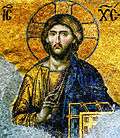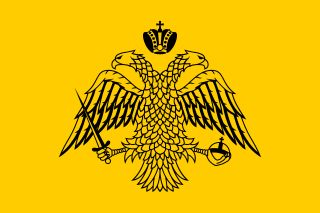Greek Orthodox Archdiocese of Italy
| Part of a series on |
| Eastern Christianity |
|---|
 |
|
Liturgy and worship |
|
The Greek Orthodox Archdiocese of Italy and Malta and Exarchate of Southern Europe is a diocese of the Ecumenical Patriarchate of Constantinople with see in Venice. The diocese was created in 1991. Current Archbishop and Metropolitan is Gennadios Zervos.
History

.jpg)
After the fall of the Western Roman Empire, the southern areas of Italy, such as Sicily, Apulia, and Calabria, remained under the control of the Eastern Roman Empire (Byzantine Empire) until the Norman conquest in the 11th century. In 1054, the Great Schism divided the Roman Catholic and the Orthodox Churches. The Orthodox bishops were replaced by Roman Catholic bishops, and many Orthodox churches, monasteries, convents, and priories were suppressed or destroyed. By 1200, this division had essentially been realized in Sicily and southern mainland Italy by the gradual appointment by the Norman kings of Roman Catholic bishops.
The Italo-Byzantine Monastery of St Mary of Grottaferrata, 20 kilometers south of Rome, was founded by St Nilus of Rossano in 1004, fifty years before the division between the Roman Catholic and the Orthodox Church, and remains to this day an enclave of Byzantine tradition under the Roman jurisdiction. The coming of Albanian and Greek Orthodox refugees to Southern Italy due to Ottoman conquests in the latter portion of the 1500s contributed to a brief revival of Orthodoxy and Greek culture, but soon the new arrivals were assimilated into the Roman Catholic Church, while preserving some of their autonomy and Byzantine Rite distinctiveness within the Italo-Albanian Catholic Church.
The Italian Orthodox Church went underground, and its Bishops had to move around to avoid persecution. Consequently, they were referred to as bishops residing in a given place, rather than as diocesan territorial overseers. However, due to its small numbers and persistent persecution by their Roman Catholic brothers, the Italian Orthodox Church became almost extinct, and there were times when gaps existed in its hierarchy. Due to persecution, the belief came into being that many married bishops were ordained secretly, although this practice was not endorsed by the Patriarchate of Constantinople. Nevertheless, the Church has survived to this day and is experiencing a period of revitalization.
After the fall of Constantinople, many Greeks sought refuge in Italy and the Ecumenical Patriarchate of Constantinople appointed a series of Metropolitans, who resided in Venice from 1537 to 1797. From the Napoleonic era until 1922, the Orthodox communities in Italy remained disorganized and dependent upon visiting priests and bishops. The continuation of that presence is represented by the Orthodox Archdiocese of Italy, which was established in 1991 by an act of the Holy Synod of the Church of Constantinople (Ecumenical Patriarchate). The Ecumenical Patriarchate of Constantinople re-organized the Orthodox churches in Italy: initially under the Exarchate of the Archdiocese of Thyateira and Great Britain (1922–1963), then under the Exarchate of the Archdiocese of Austria-Hungary (1963–1991), and finally under the newly created Archdiocese of Italy and Exarchate of Southern Europe in 1991, with its Metropolitan See in Venice. Today the archdiocese has 49 churches.
Archbishops of Italy
- Spyridon Papageorgiou (1991-1996)
- Gennadios Zervos (1996-present)
See also
References
"The Holy Orthodox Archdiocese of Italy and Malta".
